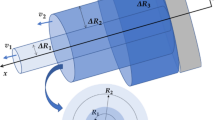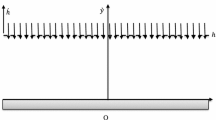Summary
This paper extends some earlier work in which consideration was given to the flow of a second-order visco-elastic liquid through a channel composed of two parallel plates, one plate having a rectangular slot cut into it perpendicular to the flow direction. In the present work the problem is re-solved for the case of an implicit Oldroyd-type model and solutions obtained using a numerical finite element technique. Severe numerical convergence difficulties are encountered when the elasticitiy of the liquid is increased. The relationship between the ratio of the hole pressure to first normal-stress difference and the Reynolds number is investigated for both Newtonian and elastic liquids and the results compared with a simple analytical analysis of Tanner and Pipkin and with the second-order fluid results of the previous paper. It is found that the value of this ratio falls as the Reynolds number is increased from zero up to 10 but that the rate of decay is less than for the second-order liquid. However in the present work elasticity is found to have a significant effect even at small Reynolds numbers, so that the ratio can deviate quite considerably from the Tanner-Pipkin theoretical value of 0.25.
Streamline patterns plotted for various flow conditions indicate that both inertia and elasticity bring about an asymmetry in the streamlines which dip into the hole, and in the vortex contained within the hole, but that the two factors work against one another so that it is possible for an elastic liquid to see a symmetric pattern for Reynolds numbers considerably beyond the range of the Tanner-Pipkin theory.
Zusammenfassung
Diese Veröffentlichung setzt eine frühere Untersuchung fort, in der die Strömung einer viskoelastischen Flüssigkeit zweiter Ordnung durch einen Kanal betrachtet wird, der aus zwei parallelen Platten besteht, wobei in die eine ein rechteckiger Schlitz quer zur Strömungsrichtung eingeschnitten ist. In der vorliegenden Arbeit wird das Problem für den Fall eines impliziten Oldroyd-Modells mit Hilfe der Methode der Finiten Elemente numerisch gelöst. Mit wachsender Elastizität stößt man dabei auf ernste Konvergenzschwierigkeiten. Die Beziehung zwischen dem Verhältnis aus Lochdruck (hole pressure) und erster Normalspannungsdifferenz und der Reynoldszahl werden sowohl für newtonsche als auch für viskoelastische Flüssigkeiten untersucht und die Ergebnisse mit denjenigen der einfachen analytischen Theorie von Tanner und Pipkin sowie mit den Ergebnissen der vorangegangenen Veröffentlichung für eine Flüssigkeit zweiter Ordnung untersucht. Man findet, daß der Wert dieses Verhältnisses beim Anwachsen der Reynolds-Zahl von null bis zehn abfällt, jedoch langsamer als für die Flüssigkeit zweiter Ordnung. Dagegen wird nun gefunden, daß die Elastizität bereits bei kleinen Reynolds-Zahlen einen deutlichen Effekt ergibt, was zu einem beträchtlichen Abweichen von dem Wert des Verhältnisses von 0,25 gemäß der Theorie von Tanner und Pipkin führen kann.
Die für verschiedene Strömungsbedingungen wiedergegebenen Stromlinienbilder zeigen, daß sowohl die Trägheit als auch die Elastizität bei den in den Schlitz eintauchenden Stromlinien und dem darunterliegenden Wirbel eine Asymmetrie erzeugen, daß aber diese beiden Einflüsse gegeneinander wirken, so daß man bei elastischen Flüssigkeiten auch symmetrische Strömungen erzeugen kann, und zwar für Reynolds-Zahlen, die deutlich unter den von der Tanner-Pipkin-Theorie vorausgesagten Werten liegen.
Similar content being viewed by others
References
Townsend, P., Rheol. Acta19 1 (1980).
Broadbent, J. M., A. S. Lodge, Rheol. Acta10 557 (1972).
Kaye, A., A. S. Lodge, D. G. Vale, Rheol. Acta7 368 (1968).
Broadbent, J. M., A. Kaye, A. S. Lodge, D. G. Vale, Nature217 55 (1968).
Lodge, A. S., Patent No. 3777549 (1973), U.S. Patent Office.
Tanner, R. T., A. C. Pipkin, Trans. Soc. Rheol.13 471 (1969).
Higashitani, K., W. G. Pritchard, Trans. Soc. Rheol.16 687 (1972).
Kearsley, A. E., Trans. Soc. Rheol.14 419 (1970).
Giesekus, L., Rheol. Acta3 59 (1963).
Tanner, R. I., Phys. Fluids9 1246 (1966).
Pipkin, A. C., Applied Mathematic Sciences7 135 (1972).
Lodge, A. S. (private communication).
Walters, K., to be published in Proc. Roy. Soc.
Han, C. D., H. J. Yoo, J. Rheology24 55 (1980).
Crochet, M. J., M. Bezy, J. Non-Newtonian Fluid Mech.5 201 (1979).
Bird, R., R. C. Armstrong, O. Hassager, Dynamics of Polymeric Liquids, Vol. 1, John Wiley, 1977.
Leal, L. G., J. Non-Newtonian Fluid Mech.5.
Zienkiewicz, O. C., The Finite Element Method, McGraw-Hill (1977).
Kawahara, M., N. Takenchi, Computers and Fluids5 33 (1977).
Coleman, C. (private communication).
Das, P. C., International Symposium on Recent Advances in Boundary Element Methods, Southampton (1978).
Tong, P., Ph. D. Thesis, 1980, U. Wisconsin-Madison.
Author information
Authors and Affiliations
Additional information
With 10 figures and 1 table
Rights and permissions
About this article
Cite this article
Richards, G.D., Townsend, P. A finite element computer model of the hole pressure problem. Rheol Acta 20, 261–269 (1981). https://doi.org/10.1007/BF01678027
Received:
Issue Date:
DOI: https://doi.org/10.1007/BF01678027




